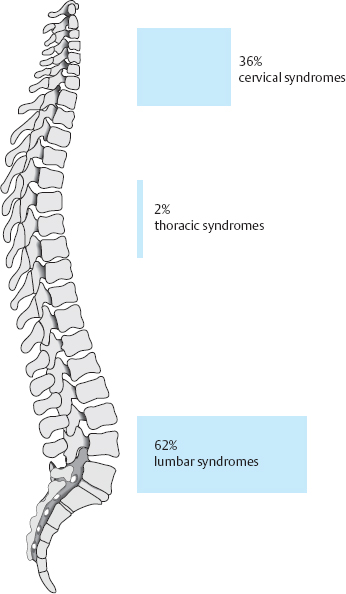3
Epidemiology
| Lifetime Prevalence | 11 | Point and Annual Prevalence | 11 |
| Localization and Frequency | 11 | International Figures | 12 |
 Lifetime Prevalence
Lifetime Prevalence
Disk-related complaints, particularly low back pain, are very common. Almost all of us will suffer at some time during our life from symptoms related to degenerative changes of the intervertebral disks: the pathoanatomical studies of Schmorl (1932), Schmorl and Junghanns (1936), Coventry (1945), Hirsch (1960), and, in our institution, Tiedjen and Müller (2001) have shown that all humans over the age of 30 have degenerative changes in their intervertebral disks. The frequency of spondylosis and osteochondrosis, which represent the final stage of degenerative disk disease, rises steadily with age and approaches 100% by age 80 or 90.
Pathoanatomically identified degenerative changes and radiological signs of disk degeneration are not necessarily accompanied by symptoms. Many individuals with documented degenerative changes are asymptomatic, or else their symptoms are not severe enough to require medical help. These “patients” with degenerative disk disease remain undetected by insurance statistics.
 Controlled studies have revealed that every older person occasionally experiences low back pain. The lifetime prevalence of this symptom is thus 100%.
Controlled studies have revealed that every older person occasionally experiences low back pain. The lifetime prevalence of this symptom is thus 100%.
There is no evidence that the prevalence of back pain has increased over the past 50 years; what has changed is the way that individuals, the medical community and society respond to back pain (Schöne 2004).
 Point and Annual Prevalence
Point and Annual Prevalence
The point prevalence of back pain is 35%; i.e., 35% of individuals will state that they are experiencing back pain on the day they are questioned, and its annual prevalence is 70% (Raspe and Kohlmann 1993, TNS-Emnid 2004, Kohlmann and Schmidt 2005, Schmidt et al. 2007). Back pain is thus at or near the top of the list in all statistical studies of human ailments ranked by frequency. The first serious illness requiring medical help in adulthood is usually a musculoskeletal illness, most often involving the spine (Ludwig et al. 1999).
Many international surveys of low back pain report a point prevalence of 15–30%, a 1-month prevalence between 19% and 43%, and a lifetime prevalence of about 60–80%. The exact figures in different studies appear to depend mainly on the wording of the question rather than any difference in the individuals studied (Nachemson 2004).
 Localization and Frequency
Localization and Frequency
The different regions of the spine are affected by intervertebral disk disease to different extents. An epidemiological review of our clinical experience of disk disease revealed that 36% of our cases involved the cervical spine, and 62% the lumbar spine (Fig. 3.1).
No exact figures are available regarding the relative frequency of various types of symptom (back pain vs. back and leg pain). Waddell’s estimates (2004) accord with those of other published reports (Bogduk 2000, Caspar 2001, Deyo 2004) and are as follows:

Fig. 3.1 The relative frequencies of disk diseases in the three regions of the spine, calculated from a large series of outpatients.
Stay updated, free articles. Join our Telegram channel

Full access? Get Clinical Tree




